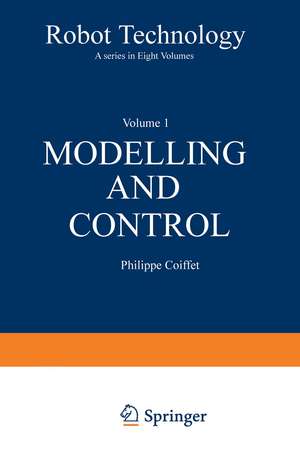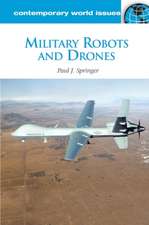Modelling and Control: Robot Technology, cartea 1
Autor P. Coiffeten Limba Engleză Paperback – 28 iun 2012
Preț: 380.25 lei
Nou
Puncte Express: 570
Preț estimativ în valută:
72.76€ • 75.82$ • 60.25£
72.76€ • 75.82$ • 60.25£
Carte tipărită la comandă
Livrare economică 03-17 aprilie
Preluare comenzi: 021 569.72.76
Specificații
ISBN-13: 9781468468489
ISBN-10: 1468468480
Pagini: 160
Ilustrații: 156 p. 4 illus.
Dimensiuni: 155 x 235 x 8 mm
Greutate: 0.23 kg
Ediția:Softcover reprint of the original 1st ed. 1983
Editura: Springer Us
Colecția Springer
Seria Robot Technology
Locul publicării:New York, NY, United States
ISBN-10: 1468468480
Pagini: 160
Ilustrații: 156 p. 4 illus.
Dimensiuni: 155 x 235 x 8 mm
Greutate: 0.23 kg
Ediția:Softcover reprint of the original 1st ed. 1983
Editura: Springer Us
Colecția Springer
Seria Robot Technology
Locul publicării:New York, NY, United States
Public țintă
ResearchCuprins
1 Definitions and objectives.- Origin of the word ‘robot’.- Robotics today.- What is a robot?.- Classification of robots.- Conclusions.- 2 Structure and specification of articulated robots.- Degrees of freedom of a solid.- Degrees of freedom of a robot.- Position of the vehicle and resulting redundancy of degrees of freedom.- How many degrees of freedom?.- False degrees of freedom.- Architecture of the arm.- Description of articulated mechanical systems.- Conclusions.- 3 Articulated mechanical systems: determination of kinematic elements.- Computation of the orientation of a chain relative to a set bound to an upper segment.- Computation of the orientation of a chain relative to a set bound to a lower segment.- Computation of the position of a point on a chain in relation to an upper segment.- Computation of the position of a point on a chain in relation to a lower segment.- Determination of the velocity vectors of rotation of different segments of a chain relative to a set of coordinate axes.- Determination of the velocity vectors of translation of different segments of a chain relative to a set of coordinate axes.- Conclusions.- 4 Calculation of robot articulation variables.- The absence of a solution.- An infinite number of solutions.- A limited number of solutions.- Practical choice of [Pi(R0), Sj(R0)].- Mechanisms with six degrees of freedom.- Mechanisms with more than six degrees of freedom.- Conclusions.- 5 Positional control of articulated robots.- Reference and starting configurations.- The principles of positional control.- Balanced and initialization configurations.- The problems associated with positional control.- 6 Speed control of articulated robots.- The principles of speed control.- Problems arising from the use of equation (6-16).- Methods ofresolving redundant systems.- Conclusions.- 7 Articulated mechanical systems: the dynamic model.- A dynamic model for an open articulated chain of rigid segments, without backlash or friction.- Development of a dynamic equation for a system having three degrees of freedom.- Another type of model: the bond graph.- Difficulties with dynamic models.- A dynamic model of a belt drive.- Conclusions.- 8 Dynamic control of articulated robots.- Problems associated with real time and computation.- Simplification of the equation of the model.- Other methods of dynamic control.- The choice of the space used in computation.- Conclusions.- 9 Learning and trajectory generation.- Methods of recording trajectories.- Manual control used outside of training.- Improved controls.- Trajectory generation.- Conclusions.- 10 Tasks and performance of articulated robots.- Description of tasks.- The performance of articulated robots.- Conclusions.- References.














